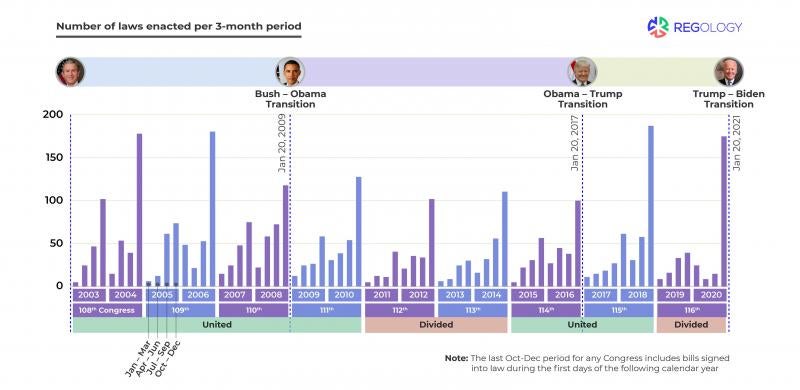The term of the 116th Congress of the United States ended on January 3rd, 2021. This date also marked the beginning of the 117th Congress, with the start of the first of two sessions in this 24-month term. Just a few days later on January 6th, 2021, it became clear that the Democratic Party would control both houses of Congress.
To get a sense of what can be expected now that the 117th Congress is underway and controlled by a single party, Regology performed an analysis of the legislative activity of the past 9 terms of Congress. Regology found that the beginning of a new Congress is marked by the introduction of a large number of bills. Although a small percentage of bills make it to law, having both houses of Congress controlled by a single party point to a significant increase in the success rate of bills being enacted.
Lawmaking by Congress: Top Three Trends
Regology identified three key trends in lawmaking activity of each Congressional term. For its analysis, Regology reviewed the bills that were introduced during the last 9 Congressional terms by both the Senate and House of Representatives, covering 18 years of lawmaking activity that led to a total of 95,000 bills reviewed. For the 9 Congressional terms reviewed, there were 6 terms where Congress was controlled by a single party and 3 terms where there was a divided Congress.
Trend 1 – 23% of all Congressional bills were introduced during the first 1/8th of the Congressional term
On average, 23% of the total amount of bills that got introduced by a Congress were introduced during the first 3 months of a Congress’ 24-month term. The large number of bills that are expected to come through in the next couple of months will not only create plenty of work for the members of Congress and their staff, law practitioners are also challenged to assess those bills that have a chance of being enacted and determine their implications on stakeholders.
Trend 2 – 26% of a Congress’ successful bills were introduced during its first 3 months
With a success rate of approximately only 3.5%, meaning the percentage of bills that got signed into law, a lot of work is of short relevance. Although this success rate may draw skepticism to pay close attention to the wave of bills the 117th Congress is introducing in its first 3 months, it is worth noting that Regology found that about 26% of the laws from the past 9 Congressional terms were introduced as bills in the first 3 months of the term.
While on average it took 235 days for a successful bill to go from introduction to enactment, successful bills introduced during the first 3 months of Congress took 300+ days before they got enacted. A visualization of the relationship between the introduction and enactment date of successful bills is shown next.
Trend 3 – 38% of a Congress’ successful bills were enacted during its last 3 months
On average 38% of all bills that became law were enacted during the last 3 months of a Congress.
Looking back: comparing the 116th Congress to the prior 8 Congressional terms
As we look at the lawmaking activity of the 116th Congress and compare it with the lawmaking activity of the prior 8 timers of Congress, the following observations can be made:
-
The 116th Congress was very active in introducing bills. Some 14,000 bills were introduced compared to roughly 10,000 bills averaged by the prior 8 sessions of Congress.
-
The 116th Congress managed to get 333 bills signed into law versus an average of 379 laws by the 8 prior sessions of Congress.
-
The success rate of bills that got signed into law for the 116th Congress stands at 2.3% versus 3.7% during the prior 8 terms. It must be noted that the 116th Congress was divided.
Lawmaking in a divided Congress
Single party control of both chambers of Congress has relevance in the number of bills they are able to pass into law. Such a Congress saw an average success rate of 4% while a divided Congress saw a success rate of 2.7%. Further analysis of the single party controlled Congressional terms revealed that the success rate was 3.7% for the 2 terms Congress was controlled by the Democratic Party and 4.2% for the 4 times the Republican Party controlled Congress. Nevertheless, the last 2 terms of Congress controlled by the Republican Party saw an average success rate of 3.4%.
Expectations for the 117th Congress
Looking at what to expect from the 117th Congress’ lawmaking activity, historical data suggests that we will see a significant number of bills being introduced on the floor in the first quarter of 2021. Furthermore, with a single party controlling both houses of Congress, these bills will have an almost 50% higher chance of making it into law.



 />i
/>i





